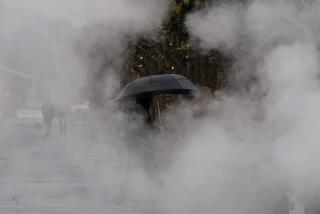Our New Orleans?
- Share via
AFTER HURRICANE KATRINA devastated New Orleans, California flood-control experts took a look at the state’s Central Valley, an area of massive population growth and home building. They shuddered at what they saw. The Sacramento Bee surveyed experts throughout the country in October, and they agreed that Sacramento now faces the highest risk of devastating floods of any major city in the nation.
Located at the confluence of the Sacramento and American rivers, much of the Sacramento metropolitan area, with an estimated population of 2 million, lies in a flood plain. Folsom Dam, just upstream on the American River, is No. 1 on the safety priority list of the U.S. Bureau of Reclamation, meaning that its limited flood-control capacity puts Sacramento at risk of inundation. Flood-control improvements at the 50-year-old dam have repeatedly been delayed by political bickering.
Most of Sacramento is saved from routine flooding only by miles of levees, many of dubious reliability. Area flood-control officials say that more than 300,000 people and 140,000 structures could be affected by a serious flood.
The historical record suggests that there is a 1-in-100 chance of a massive flood in the city each year. Those odds become even worse when the maintenance of levees is deferred, as it has long been in the Central Valley.
In general, homeowners are not required by lenders to carry flood insurance, even if they live in flood plains. And many do not. That means taxpayers will doubtless be stuck with the bill when and if Sacramento becomes another New Orleans.
Sacramento suffered severe flooding twice in recent years, in 1986 and 1997. In the latter year, more than 120,000 residents were evacuated from their homes and 30,000 homes and 2,000 businesses were destroyed. Much of the flooding occurred just north of Sacramento, where a levee failed.
The risk goes far beyond the Sacramento area. Homes and farmland throughout the Sacramento and San Joaquin valleys are protected by 1,600 miles of levees. Local planning officials routinely allow new housing projects within the flood plain. The Sacramento-San Joaquin Delta contains an additional 1,000 miles of locally maintained levees. A catastrophic levee break could threaten a major water supply to 22 million Southern Californians.
What can be done? The experts say the first priority is to make sure disaster and evacuation plans are up to date and adequate. Billions of dollars are needed to bring maintenance of levees up to adequate levels, but this would take years even if the money were available -- which, unless a multibillion-dollar infrastructure bond being discussed in Sacramento becomes a reality, it isn’t.
Meanwhile, officials should stop new construction in flood-prone areas. And both the governor and the Legislature need to address these issues with a sense of urgency, beginning now.
More to Read
Sign up for Essential California
The most important California stories and recommendations in your inbox every morning.
You may occasionally receive promotional content from the Los Angeles Times.










